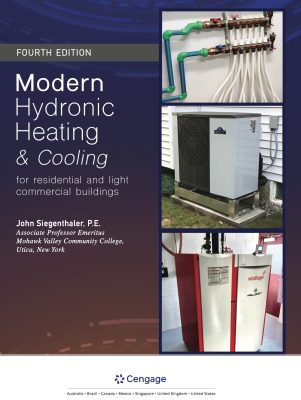Overkill

Over the last few years, hydraulic separators have been gaining popularity in the North American hydronics market. They provide an alternative to closely spaced tees when the task is to isolate the pressure dynamics of one hydronic circuit from those of another, connected circuit.
Eager to keep up with this new technology, an installer decides to install a hydraulic separator between a boiler and distribution system as shown in the figure below. This system serves space-heating loads at two different supply temperatures. It also serves a prioritized indirect water heater.
Look over the drawing and see if you can spot both errors, and methods of achieving the desired operation with simpler piping and less hardware.

The Fix
A hydraulic separator eliminates the need to use closely spaced tees when connecting load circuits. All load circuits can be piped across the headers. Those headers should be short and sized for a maximum flow velocity of 2 feet per second. This keeps the pressure drop along the length of the header extremely small (e.g., negligible).The slow flow rate along the vertical height of the hydraulic separator adds virtually nothing to this pressure drop. Thus, the differential pressure between the upper and lower headers is essentially zero. Each load connected across the headers is unable to detect the presence of the other load circuits.
Using closely spaced tees downstream of the hydraulic separator, along with an additional circulator (at the far right side of the schematic), is totally unnecessary.
Other errors in the original drawing include:
1. Reversed piping connections on the coil heat exchanger in the indirect water heater (hot water should always enter at the top connection).
2. The expansion tank should be connected to the system near one of the lower side ports of the hydraulic separator, not on the outside of a circulator as shown.
3. Circulators should push flow into the compact mod/con boiler to keep internal pressure up and avoid potential for steam flash. The circulator serving the indirect water heater is attempting to “suck” water through the boiler. Not a good idea, especially since the water temperature is likely to be elevated during the domestic water heating cycle.
4. The purging valve between the hydraulic separator and boiler circulator is reversed.
5. The unions and isolation valves near the boiler are upside down (e.g., the unions need to be between the isolation valves and the boiler).
6. Although this is a schematic, and not a scale drawing, I prefer to show a longer length of piping on the inlet side of the circulators. In the field, there should be at least 12 pipe diameters of straight pipe upstream of each circulator.
7. The two sets of closely spaced tees are in series; thus, the supply water temperature to the second set of tees will be lower than to the first. While this doesn’t guarantee a problem, it simply is not an issue when the loads are connected as shown in the fix drawing.
Links
Looking for a reprint of this article?
From high-res PDFs to custom plaques, order your copy today!








